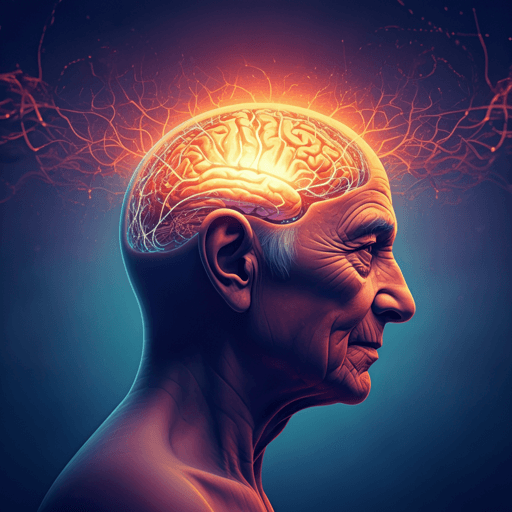
Medicine and Health
Four weeks of meditation training improves sustained attention in community-dwelling older adults: a proof-of-concept randomized controlled trial
S. D. Ford and L. S. Nagamatsu
A randomized trial showed that 4 weeks of thrice-weekly focused attention meditation improved attention in older adults, evidenced by better Sustained Attention to Response Task (SART) accuracy and changes in N2 event-related potentials. The research was conducted by Sabrina D. Ford and Lindsay S. Nagamatsu.
~3 min • Beginner • English
Introduction
The study addresses the need for effective, accessible interventions to improve attention in older adults, given age-related declines and the importance of sustained attention for daily activities, driving, balance, and mobility. The authors investigated whether a 4-week, thrice-weekly focused attention (breath-focused) meditation program would improve sustained attention compared to an active music listening control. They also explored whether benefits transfer to executive functions, mobility, and mood, and aimed to probe neural mechanisms via ERPs during a sustained attention task. The hypothesis was that meditation training would lead to improvements in sustained attention relative to the music control.
Literature Review
Attention declines with age, and impaired attention is associated with increased fall risk and alterations in processing task-relevant and irrelevant visual information. Prior work shows meditation can improve attention and sustained attention, including in older adults, with a meta-analysis (Mirabito and Verhaeghen, 2023) reporting significant improvements irrespective of age, intervention length, or gender. Short-term and intensive meditation training have improved perceptual discrimination and sustained attention (MacLean et al., 2010), and experienced older meditators show better sustained attention than non-meditators (Sperduti et al., 2016). However, many studies rely on behavioral measures without neural indices and lack real-world functional outcomes, motivating inclusion of ERPs and mobility measures in this trial.
Methodology
Design: Four-week, single-blinded randomized controlled trial conducted January–August 2019; registered (NCT03417635) and approved by Western University's HSREB. Randomization used randomization.com with blocks of 2, 4, and 6; allocation concealed until baseline completion; assessors blinded. Participants: Community-dwelling older adults (London, Ontario) meeting inclusion criteria (independent living; completed high school; English literacy; independent ambulation; IADL ≥6/8; MMSE >24/30) and excluding neurodegenerative disease, cognitive impairment, psychiatric conditions, recent concussion, stroke, musculoskeletal/joint disease, balance issues, uncorrected sensory impairments, or recent meditation practice. Recruitment via community groups, flyers, presentations, online and newspaper ads. Procedure: Two baseline sessions (demographics, cognitive, mobility, mood measures; then SART with EEG) separated by ~10 days (range 1–42). Post-intervention, participants repeated both sessions. Intervention: 12 in-person sessions over 4 weeks (3×/week; 20 min each), group size 1–5 (avg ~3), led by a trained instructor. Experimental group: focused attention (breath) meditation with options to sit/lie, eyes closed or unfocused; three techniques introduced (breath sensation at nose; posture imagery with inhale/exhale; counting breaths to 10), progressing to more silence and fewer reminders; encouraged home practice. Control group: instrumental jazz listening with relaxed posture, eyes closed/relaxed, mind wandering; provided track for home listening. Primary outcome: SART behavioral performance (go/no-go accuracy and reaction times) across 14 blocks (60 stimuli each; target digit 3; go responses via right index; mandatory mid-task break; left-handed participants did not complete SART). Stimuli: 0–9 digits, 500 ms presentation, jittered ISI 900–1100 ms; 5 or 7 targets per block. Secondary outcome: ERPs during SART focusing on N2 (150–400 ms, Fz) and P3 (300–500 ms, Fz/Cz). EEG: 64-channel actiCHamp; 10–20 montage; ground Fpz; reference AFz (offline re-ref to mastoids); sampling 500 Hz; low-pass 0.05 Hz at recording; impedances <20 kΩ; EOG recorded. Processing in ERPLab: mastoid re-ref; correct-response trials binning; epochs −200 to +1000 ms with baseline correction; artifact rejection via EOG moving window peak-to-peak; averaging; Butterworth filters (0.1–30 Hz). Extracted peak latency (N2: 200–400 ms; P3: 400–600 ms) and mean amplitude (±20 ms around peak) at Fz, Cz, Pz, Oz for go/no-go and both timepoints. Tertiary outcomes: Executive function (Digit Span forwards–backwards difference; Trail Making Test B–A time difference; Stroop C–B time difference), mobility (ABC scale; TUG; SPPB), mood (DASS-21 subscales: depression, anxiety, stress), and everyday attention (CFQ). Statistical analysis: Baseline group comparisons via t-tests/chi-square. Repeated-measures ANOVAs for time (pre vs post) × group (meditation vs control); ERP analyses also included electrode factor (site effects not reported). Due to early termination (COVID-19), alpha set at p ≤ 0.10 to preserve intended power; effect sizes reported as partial eta squared (ηp²: small 0.01, medium 0.06, large 0.14). Intention-to-treat included participants with data at both timepoints; dropouts with no endpoint data excluded. Analyses conducted in SPSS v27 (Mac). Attendance: All participants who started completed all 12 sessions.
Key Findings
Sample: 43 randomized (22 meditation; 21 music). Five dropped before starting (2 meditation; 3 music). Final analyzed sample: 38 (20 meditation; 18 music). Baseline groups did not differ. Primary (SART behavioral): - Go trials accuracy: Significant time × group interaction favoring meditation, F(1,30) = 5.599, p = 0.025, ηp² = 0.157. No significant RT differences over time or between groups (all p > 0.169). - No-go trials accuracy: Main effect of time (both groups improved), F(1,30) = 15.752, p < 0.001, ηp² = 0.344; trend for time × group interaction (meditation improved more), F(1,30) = 2.838, p = 0.102, ηp² = 0.086. - Correlation: Slower go RT associated with better no-go withholding, r(34) = 0.501, p = 0.001. Secondary (ERPs): - N2 go trials: Peak latency shifted earlier post-intervention across groups, main effect of time F(1,30) = 3.652, p = 0.066, ηp² = 0.109. - N2 no-go trials: Mean amplitude became more negative and peak latency shifted earlier in meditation vs control, time × group interactions F(1,30) = 3.221, p = 0.083, ηp² = 0.097 (amplitude) and F(1,30) = 3.029, p = 0.092, ηp² = 0.092 (latency). - P3 go trials: Mean amplitude increased post-intervention overall, time effect F(1,30) = 3.347, p = 0.077, ηp² = 0.100; driven by control at frontal sites with time × electrode × group interaction F(1.472,44.162) = 4.223, p = 0.031, ηp² = 0.123. Peak latency decreased overall, time effect F(1,30) = 3.123, p = 0.087, ηp² = 0.094. - P3 no-go trials: Mean amplitude increased in control and decreased in meditation, time × group interaction F(1,30) = 3.583, p = 0.068, ηp² = 0.107. Tertiary outcomes: - Executive function: Working memory (Digit Span difference) improved in meditation vs control, time × group interaction F(1,36) = 5.437, p = 0.025, ηp² = 0.131; no significant effects for set-shifting (TMT B–A) or Stroop C–B. - Mobility: ABC balance confidence improved across groups, time effect F(1,36) = 6.640, p = 0.014, ηp² = 0.156; TUG times improved across groups, time effect F(1,36) = 6.829, p = 0.013, ηp² = 0.159; SPPB showed no change. - Mood: DASS anxiety decreased, time effect F(1,36) = 4.828, p = 0.035, ηp² = 0.118; stress decreased, time effect F(1,36) = 6.172, p = 0.018, ηp² = 0.146. - Everyday attention: CFQ decreased more in meditation vs control, time × group interaction F(1,36) = 3.862, p = 0.057, ηp² = 0.097.
Discussion
Meditation training improved sustained attention at the behavioral level (greater SART accuracy on go and no-go trials) and was accompanied by neurophysiological changes indicative of enhanced inhibitory control (larger/more negative and earlier N2 on no-go trials) and altered motor inhibition (P3 changes). The correlation between slower go RT and better no-go accuracy suggests a careful response strategy relates to inhibition performance, but ERP findings imply genuine changes in executive processing beyond simple speed-accuracy trade-offs. Working memory gains were observed, while set-shifting and Stroop inhibition did not change, possibly due to task sensitivity or domain-specific effects. Both groups showed reduced anxiety and stress and improvements in balance confidence and mobility, highlighting potential benefits of social engagement and relaxation common to both interventions; nevertheless, the attentional benefits appear specific to meditation and not solely attributable to mood changes. The ERP pattern supports improved frontal inhibitory control mechanisms potentially linked to ACC connectivity reported in prior meditation studies, suggesting meditation can modulate cognitive control networks in older adults.
Conclusion
A four-week focused attention meditation program improved sustained attention in healthy community-dwelling older adults, with corresponding changes in electrophysiological markers of inhibitory control (N2) and improvements in working memory and everyday attentional failures. Given attention’s central role in mobility and daily functioning, meditation may be a cost-effective, scalable approach to bolster cognitive health in aging. Future research should conduct full-scale definitive RCTs with larger samples, conservative statistical thresholds, longer follow-up, alternative control conditions, subgroup analyses, and clinically meaningful endpoints (e.g., falls) to confirm efficacy, elucidate mechanisms, and assess real-world transfer.
Limitations
Active control participants may have engaged in relaxation techniques resembling meditation (e.g., breath focus, imagery), potentially diluting between-group differences. Some meditation participants fell asleep during sessions, reducing active practice exposure. The trial used a smaller sample and a liberal alpha (p ≤ 0.10) due to early termination from COVID-19, limiting generalizability and statistical rigor and preventing subgroup analyses. Ceiling effects in SART go accuracy may have constrained detection of differences. The pen-and-paper Stroop may have lacked sensitivity to detect changes in response inhibition. Overall, effects may be conservative estimates; more rigorous, larger trials are needed.
Related Publications
Explore these studies to deepen your understanding of the subject.







